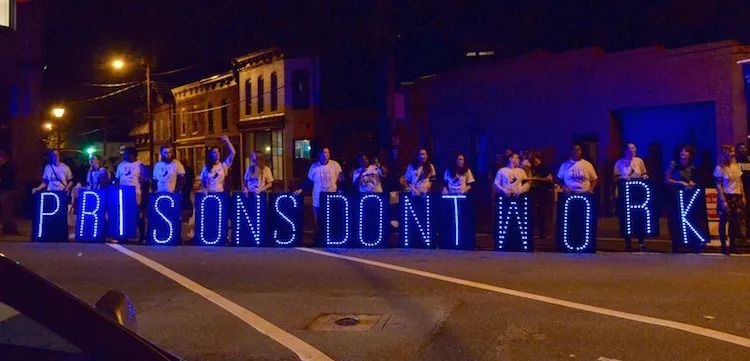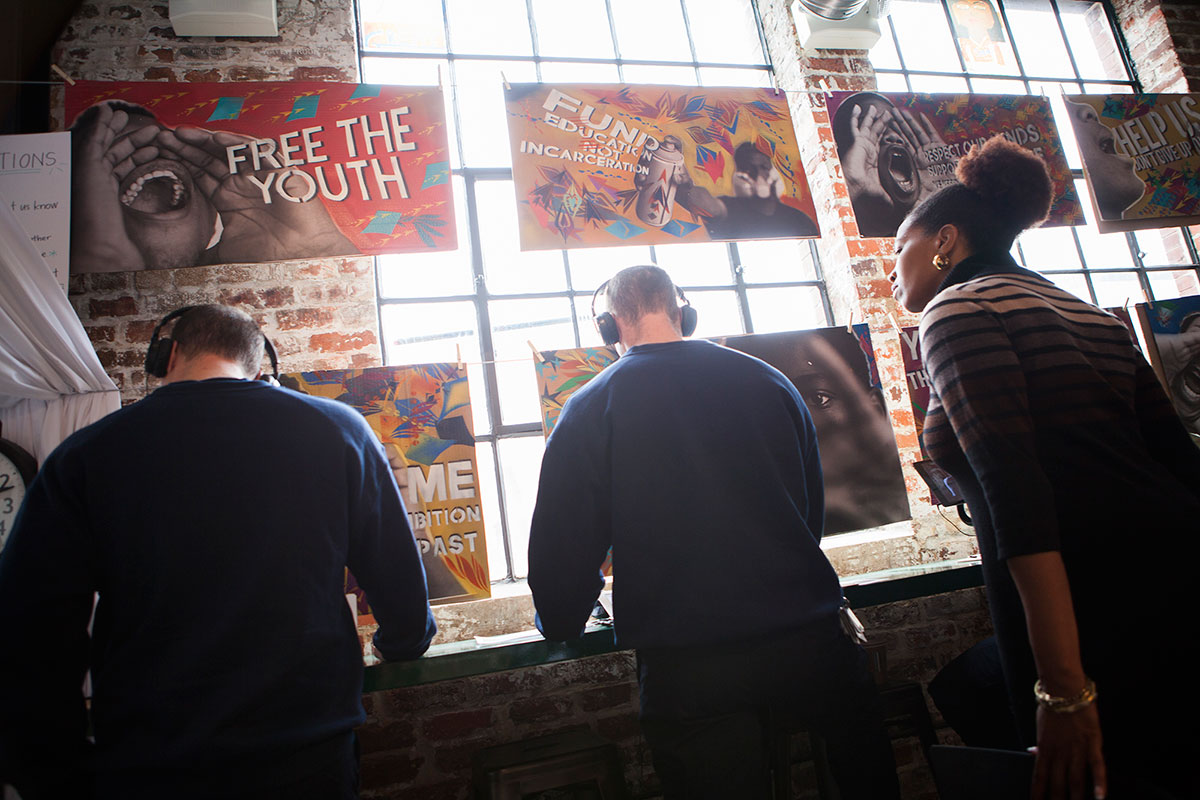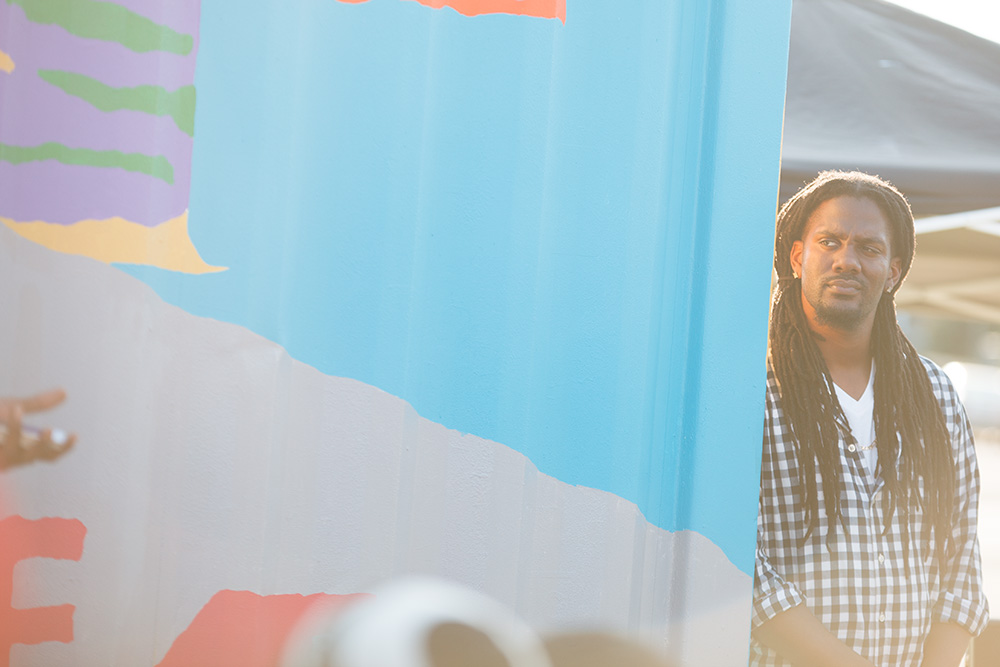A Better Kind of Pipeline, Through Restorative Practice (Part 1)

Meet Michael O’Bryan and Mark Strandquist—Michael is the Director of Youth and Young Adult Programs at North Philadelphia’s The Village of Arts and Humanities, and Mark is the cultural organizer behind Reentry Think Tank and the People’s Paper Co-Op (a program of The Village of Arts and Humanities, both co-directed with Courtney Bowles), and Performing Statistics in Richmond, VA. Both are part of Create Justice, a group of like-minded activists, artists, and others who are collectively organizing around creating a youth reentry network for Philadelphia. Our Restorative Practices Youth initiative is currently at work on a project with Mark, collaborating with teens at five different adjudicated sites around the city. Michael and Mark are collaborators in the same field and the same city (and both Geminis!) so we brought them together to chat about restorative practices.
On their work in restorative practice:
Michael: My work centers around honoring the nuances of our humanity, collectively and individually. It’s very informed by working in the sciences, by time spent learning from really brilliant, really compassionate and empathic clinicians—and also time spent in environments that were not home, not comfortable for me in a cultural context. I spent time working and living on a migrant farmworkers’ camp. I felt good and I appreciated the people that I was learning from, but it was uncomfortable because I kept learning about the marginalization of so many groups of people who are always spoken for and at. There’s no way to be comfortable through that. There are experiences that are never comfortable, and should never become comfortable, because that probably indicates that something is not right. My career’s been fortunately saturated with those kinds of experiences. I seek them out, to learn as much as possible and bring it to bear in whatever programming I’m designing or co-designing—I like to collaborate a lot, particularly with young people, or with older people who rarely collaborate. My work at the Village is informed by all of that, because we really believe in the values of co-design, co-creation, and co-curation. Designing with and as a good neighbor, as opposed to designing for. Our youth programs exist in that space.
Mark: Performing Statistics is a multi-year project that began four years ago. We work with kids while they’re incarcerated, through a program where they’re able to actually leave their detention center, to come to a window-filled space where there are formerly incarcerated mentors—which is key, because the curriculum has always been co-designed by people who have gone through the system themselves. Gina Lyles, our program coordinator who has direct experience in the system, has been one of the leaders in the project. We do trauma trainings for all of our instructors, so that we’re making sure that we’re challenging and motivating the teens, but not triggering them into a space they don’t need to go to. We work every week with the teens to connect them with not only amazing artists—like our virtual reality team, photographers, and filmmakers—but also the state’s top legal advocates.
So they’re learning about the legal side of the system, and they’re working with artists and storytellers to think about how they can combine legal knowledge with personal experiences, to reimagine what the juvenile justice system could look like, to imagine a world without the school-to-prison pipeline. We’ve traveled all over the state and hundreds of thousands of people have seen the teens’ work, but they’ve also created their own police training manuals and an immersive training experience, which Mike has been part of. It’s being rolled out now to train every single police officer in the city of Richmond. The teens made a virtual reality film that is getting put into a headset that every single police officer in this city is going to have to put on, as well as seeing all the other artwork that the teens have made. That will then become a classroom space for Mike and others to take those police officers on a deeper dive into youth development, trauma, reimagining and identifying the police’s role within the school-to-prison pipeline, and working with them to propose solutions.

On listening to youth as the experts on their own lives:
Michael: In terms of expertise, the Village provides opportunity for young people to use media and artmaking as ways to communally explore narratives of all kinds: your neighborhood, your ethnic group and all the subcultures that emerge out of that, youth culture, your school—anything. We allow for inquiry and interrogation of those spaces, and we also allow for people to explore their own personal narratives, looking through the meanings that they’ve made out of experience. We don’t pick the experiences—sometimes we make suggestions and see what that pulls up, because for some people, choice can be scary if you’ve never had it before. We always give opportunity to grow that suggestion or come up with your own thing, as long as it’s thoughtful. If you come in saying, “I just want to rap about gummy bears,” well…maybe not. Unless it’s a thoughtful use of gummy bears. So restorative practice informs the work in that way, and it also informs the overarching program design.
Mark: Our projects [at Performing Statistics] delve into the school-to-prison pipeline, and also are centered on the idea of expertise, looking to youth most affected by the juvenile justice system—incarcerated youth themselves, their families, their communities—as the experts for developing policies or designing services. We should not only be looking to them to tell their own stories, but also co-designing the services and institutions that they engage with. A lot of our projects begin with a question, not an answer: how would criminal justice reform differ if it were led by incarcerated youth? How can artists, lawyers, advocates, and others really support those youth and amplify their vision for a more just and whole world?

On changing the meaning of the term “pipeline”:
Mark: For us, we not only see youth as experts in the best position to reimagine the system, but we also see all of us as actors along the school-to-prison pipeline. So we find ways that our exhibits can be, rather than passive viewing experiences for people to pat themselves on the back, acknowledgement that we can all be positive or negative parts of the system. As an artist, my responsibility is to ensure that these stories connect with the right people. We do that with the police trainings, with the parade where the art gets marched down Richmond’s main streets, creating mobile exhibits to enter classrooms and museums, just trying to do the stories justice. Of course when you’re asking teens what they need to stay free: jobs. And many other things like mental health support, housing, family reunification, but these are all basic needs. We designed a fellowship that connects youth in our program with creative jobs that they identify. So one of the teens in our program is co-teaching a college class now—shifting that pipeline, going from a juvenile prison into a college classroom where they’re looked to as a leader, somebody with a lot to share, not as the worst of society, as the system tries to paint them.
Michael: About a year and a half ago, I had students who needed to work, and they were going to leave the program to get a job at CVS, or Family Dollar, one of those places. I’m not judging those jobs—at 15 or 16 years old, I get that money is important and you need it, particularly if you’re impacted by disinvestment and the city’s poverty epidemic. But I don’t know if trading in working with Dilemma—who’s a Grammy-nominated producer, who’s traveling the world and endorsed by Lenovo, with a lot of information and a wealth of experience to share, who can bring these young people to places most of them have dreamt about—I don’t know if that’s worth exchanging 25 hours at minimum wage for. But I also can’t ignore the fact that your lived expertise is demonstrating to you at 15 that you’re set up for a trajectory that’s not helping you survive. So we redesigned the program. We said, what if we focus on workforce development for the creative economy, the innovation economy, the tech sector? What if we stop supporting, in a sense, the tale of two Philadelphias, where Center City has its own bustling start-up culture, and all these innovative spaces and social solutions, while the expertise of our young people is sitting in the middle of Fairhill. Shouldn’t there be a bi-directional exchange between these groups?
So now they get paid for doing work, real work. We can connect young people to real-life clients, sometimes one-off, sometimes recurring. Photobooths, story collection booths, all kinds of stuff. I hope it helps. I know it’s helped keep those students around, and it’s encouraged more students to get involved, but it’s still not enough money. I want to work on that. We need better pipelines to jobs that utilize the skillsets that we’re hoping to build for our young people. It’s something we’re working on with the Arts + Business Council and some other folks: what does a different kind of pipeline look like and who are the early adopters? But all that needs to be informed by the experience of the youth.

